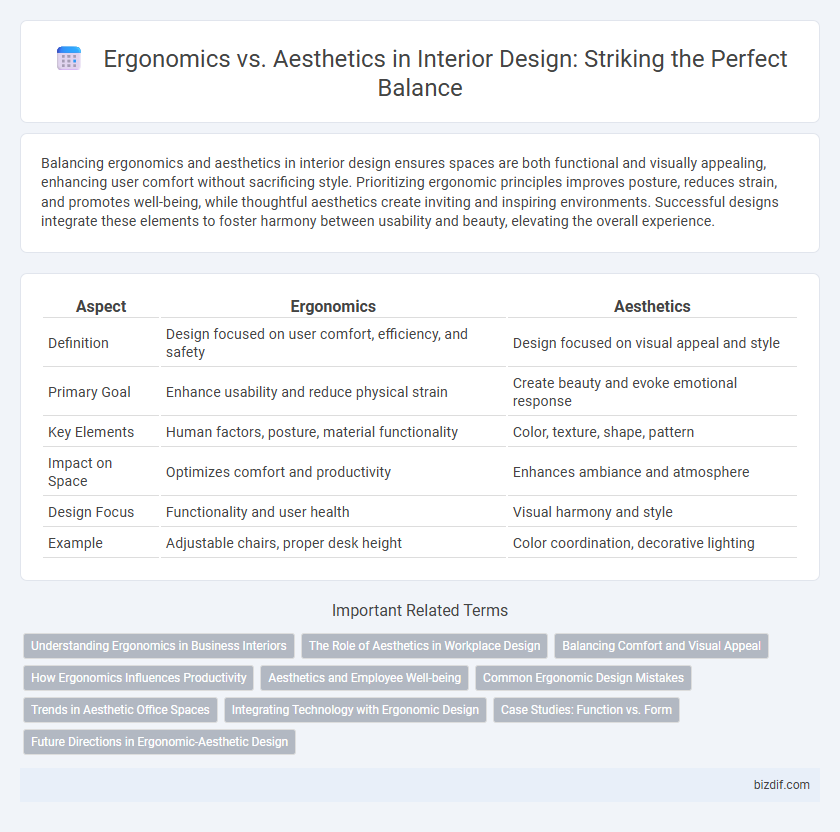Balancing ergonomics and aesthetics in interior design ensures spaces are both functional and visually appealing, enhancing user comfort without sacrificing style. Prioritizing ergonomic principles improves posture, reduces strain, and promotes well-being, while thoughtful aesthetics create inviting and inspiring environments. Successful designs integrate these elements to foster harmony between usability and beauty, elevating the overall experience.
Table of Comparison
| Aspect | Ergonomics | Aesthetics |
|---|---|---|
| Definition | Design focused on user comfort, efficiency, and safety | Design focused on visual appeal and style |
| Primary Goal | Enhance usability and reduce physical strain | Create beauty and evoke emotional response |
| Key Elements | Human factors, posture, material functionality | Color, texture, shape, pattern |
| Impact on Space | Optimizes comfort and productivity | Enhances ambiance and atmosphere |
| Design Focus | Functionality and user health | Visual harmony and style |
| Example | Adjustable chairs, proper desk height | Color coordination, decorative lighting |
Understanding Ergonomics in Business Interiors
Ergonomics in business interiors prioritizes designing workspaces that enhance employee comfort, reduce physical strain, and boost productivity by considering human body mechanics and movement patterns. Effective ergonomic design incorporates adjustable furniture, optimal desk heights, and proper lighting to create a healthier work environment. Balancing ergonomics with aesthetics ensures that office spaces not only look visually appealing but also support workers' well-being and efficiency.
The Role of Aesthetics in Workplace Design
Aesthetics in workplace design significantly impact employee well-being and productivity by creating visually stimulating and comfortable environments. Incorporating elements like color psychology, natural light, and art enhances mood and reduces stress, influencing overall job satisfaction. Balancing aesthetic appeal with ergonomic functionality ensures a harmonious workspace that supports both health and creativity.
Balancing Comfort and Visual Appeal
Balancing comfort and visual appeal in interior design requires integrating ergonomic principles with aesthetic choices to create spaces that support physical well-being while enhancing style. Prioritizing ergonomic furniture and layouts improves posture and reduces strain, while thoughtful color schemes, textures, and decorative elements enrich the visual environment. Achieving harmony between ergonomics and aesthetics results in functional yet attractive interiors that elevate user experience and satisfaction.
How Ergonomics Influences Productivity
Ergonomics in interior design enhances productivity by creating spaces that reduce physical strain and improve comfort, allowing users to maintain focus and efficiency for longer periods. Proper ergonomic furniture and layout minimize fatigue and prevent musculoskeletal issues, directly impacting work performance. Balancing ergonomics with aesthetics ensures functional environments without compromising visual appeal, promoting both health and motivation.
Aesthetics and Employee Well-being
Aesthetics in interior design plays a crucial role in enhancing employee well-being by creating visually stimulating and harmonious work environments that reduce stress and boost morale. Thoughtful color schemes, natural lighting, and appealing decor positively influence mood and productivity, making the workspace inviting and comfortable. Balancing aesthetic elements with ergonomic functionality ensures a holistic approach that supports both emotional satisfaction and physical health.
Common Ergonomic Design Mistakes
Common ergonomic design mistakes in interior design include neglecting proper furniture height, inadequate lumbar support, and ignoring natural movement patterns, leading to discomfort and reduced productivity. Prioritizing aesthetics over ergonomics often results in visually appealing spaces that compromise user health and functionality. Incorporating adjustable seating, appropriate desk heights, and mindful layout planning balances both ergonomic needs and aesthetic appeal effectively.
Trends in Aesthetic Office Spaces
Modern aesthetic office spaces prioritize biophilic design trends that incorporate natural elements to boost employee well-being and productivity. Ergonomics remains essential, with adjustable furniture and sit-stand desks promoting comfort while blending seamlessly into minimalist, visually appealing interiors. Bold color palettes, textured materials, and smart lighting systems create dynamic environments that balance functionality and style.
Integrating Technology with Ergonomic Design
Integrating technology with ergonomic design enhances both functionality and user comfort, creating spaces that adapt to individual needs while maintaining visual appeal. Smart furniture equipped with adjustable settings and sensors ensures optimized posture and reduces physical strain, seamlessly blending innovation with interior aesthetics. This symbiosis of technology and ergonomics drives efficient, health-conscious environments without compromising design elegance.
Case Studies: Function vs. Form
Case studies in interior design reveal the critical balance between ergonomics and aesthetics, showcasing spaces that prioritize user comfort without sacrificing visual appeal. Analysis of corporate office layouts demonstrates how ergonomic furniture and spatial arrangements enhance productivity while maintaining brand identity through cohesive color schemes and textures. Residential projects highlight the successful integration of functional elements, such as adjustable lighting and modular seating, with stylish materials and artistic decor to create both practical and inviting environments.
Future Directions in Ergonomic-Aesthetic Design
Future directions in ergonomic-aesthetic design emphasize integrating smart materials and adaptive furniture to enhance both comfort and visual appeal. Advanced user-centric technologies, such as AI-driven customization and biometric feedback systems, enable personalized environments that optimize posture and reduce strain while maintaining stylish interiors. Sustainable design practices increasingly influence ergonomic solutions, promoting eco-friendly materials that support health and elevate aesthetic value.
Ergonomics vs Aesthetics Infographic

 bizdif.com
bizdif.com